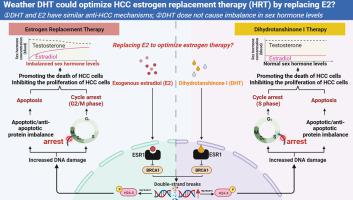当前位置:
X-MOL 学术
›
Phytomedicine
›
论文详情
Our official English website, www.x-mol.net, welcomes your feedback! (Note: you will need to create a separate account there.)
Dihydrotanshinone I targets ESR1 to induce DNA double-strand breaks and proliferation inhibition in hepatocellular carcinoma
Phytomedicine ( IF 6.7 ) Pub Date : 2024-05-24 , DOI: 10.1016/j.phymed.2024.155767 Yunmeng Nie , Junbin Yan , Xueru Huang , Tao Jiang , Shuo Zhang , Guangji Zhang
Phytomedicine ( IF 6.7 ) Pub Date : 2024-05-24 , DOI: 10.1016/j.phymed.2024.155767 Yunmeng Nie , Junbin Yan , Xueru Huang , Tao Jiang , Shuo Zhang , Guangji Zhang

|
Due to its high incidence and elevated mortality, hepatocellular carcinoma (HCC) has emerged as a formidable global healthcare challenge. The intricate interplay between gender-specific disparities in both incidence and clinical outcomes has prompted a progressive recognition of the substantial influence exerted by estrogen and its corresponding receptors (ERs) upon HCC pathogenesis. Estrogen replacement therapy (ERT) emerged for the treatment of HCC by administering exogenous estrogen. However, the powerful side effects of estrogen, including the promotion of breast cancer and infertility, hinder the further application of ERT. Identifying effective therapeutic targets for estrogen and screening bioactive ingredients without E2-like side effects is of great significance for optimizing HCC ERT. In this study, we employed an integrative approach, harnessing data from the Cancer Genome Atlas (TCGA) and Gene Expression Omnibus (GEO) databases, clinical paraffin sections, adenoviral constructs as well as in vivo studies, to unveil the association between estrogen, estrogen receptor α (ESR1) and HCC. Leveraging methodologies encompassing molecular dynamics simulation and cellular thermal shift assay (CETSA) were used to confirm whether ESR1 is a molecular target of DHT. Multiple in vitro and in vivo experiments were used to identify whether i) ESR1 is a crucial gene that promotes DNA double-strand breaks (DSBs) and proliferation inhibition in HCC, ii) Dihydrotanshinone I (DHT), a quinonoid monomeric constituent derived from Salvia miltiorrhiza (Dan shen) exerts anti-HCC effects by regulating ESR1 and subsequent DSBs, iii) DHT has the potential to replace E2. DHT could target ESR1 and upregulate its expression in a concentration-dependent manner. This, in turn, leads to the downregulation of breast cancer type 1 susceptibility protein (BRCA1), a pivotal protein involved in the homologous recombination repair (HRR) process. The consequence of this downregulation is manifested through the induction of DSBs in HCC, subsequently precipitating a cascade of downstream events, including apoptosis and cell cycle arrest. Of particular significance is the comparative assessment of DHT and isodose estradiol treatments, which underscores DHT's excellent HCC-suppressive efficacy without concomitant perturbation of endogenous sex hormone homeostasis. Our findings not only confirm ESR1 as a therapeutic target in HCC management but also underscores DHT's role in upregulating ESR1 expression, thereby impeding the proliferation and invasive tendencies of HCC. In addition, we preliminarily identified DHT has the potential to emerge as an agent in optimizing HCC ERT through the substitution of E2.
中文翻译:

二氢丹参酮 I 靶向 ESR1 诱导肝细胞癌 DNA 双链断裂和增殖抑制
由于其高发病率和较高的死亡率,肝细胞癌(HCC)已成为全球医疗保健的一项艰巨挑战。发病率和临床结果方面的性别差异之间错综复杂的相互作用促使人们逐渐认识到雌激素及其相应受体 (ER) 对 HCC 发病机制的重大影响。雌激素替代疗法(ERT)的出现是通过施用外源性雌激素来治疗 HCC。然而,雌激素强大的副作用,包括促进乳腺癌和不孕症,阻碍了ERT的进一步应用。确定雌激素的有效治疗靶点并筛选无E2样副作用的生物活性成分对于优化HCC ERT具有重要意义。在这项研究中,我们采用综合方法,利用癌症基因组图谱 (TCGA) 和基因表达综合 (GEO) 数据库、临床石蜡切片、腺病毒构建体以及体内研究的数据,揭示雌激素、雌激素之间的关联受体 α (ESR1) 和 HCC。利用分子动力学模拟和细胞热位移测定 (CETSA) 等方法来确认 ESR1 是否是 DHT 的分子靶标。使用多项体外和体内实验来确定 i) ESR1 是否是促进 HCC 中 DNA 双链断裂 (DSB) 和增殖抑制的关键基因,ii) 二氢丹参酮 I (DHT),一种源自丹参的醌类单体成分丹参通过调节 ESR1 和随后的 DSB 发挥抗 HCC 作用,iii) DHT 有替代 E2 的潜力。 DHT 可以靶向 ESR1 并以浓度依赖性方式上调其表达。 这反过来又导致 1 型乳腺癌易感蛋白 (BRCA1) 下调,该蛋白是参与同源重组修复 (HRR) 过程的关键蛋白。这种下调的结果通过在 HCC 中诱导 DSB 来体现,随后引发一系列下游事件,包括细胞凋亡和细胞周期停滞。特别重要的是对 DHT 和等剂量雌二醇治疗的比较评估,这强调了 DHT 优异的 HCC 抑制功效,且不会同时扰乱内源性激素稳态。我们的研究结果不仅证实了 ESR1 作为 HCC 治疗的治疗靶点,而且还强调了 DHT 在上调 ESR1 表达中的作用,从而阻止 HCC 的增殖和侵袭倾向。此外,我们初步确定DHT有潜力通过替代E2作为优化HCC ERT的药物。
更新日期:2024-05-24
中文翻译:

二氢丹参酮 I 靶向 ESR1 诱导肝细胞癌 DNA 双链断裂和增殖抑制
由于其高发病率和较高的死亡率,肝细胞癌(HCC)已成为全球医疗保健的一项艰巨挑战。发病率和临床结果方面的性别差异之间错综复杂的相互作用促使人们逐渐认识到雌激素及其相应受体 (ER) 对 HCC 发病机制的重大影响。雌激素替代疗法(ERT)的出现是通过施用外源性雌激素来治疗 HCC。然而,雌激素强大的副作用,包括促进乳腺癌和不孕症,阻碍了ERT的进一步应用。确定雌激素的有效治疗靶点并筛选无E2样副作用的生物活性成分对于优化HCC ERT具有重要意义。在这项研究中,我们采用综合方法,利用癌症基因组图谱 (TCGA) 和基因表达综合 (GEO) 数据库、临床石蜡切片、腺病毒构建体以及体内研究的数据,揭示雌激素、雌激素之间的关联受体 α (ESR1) 和 HCC。利用分子动力学模拟和细胞热位移测定 (CETSA) 等方法来确认 ESR1 是否是 DHT 的分子靶标。使用多项体外和体内实验来确定 i) ESR1 是否是促进 HCC 中 DNA 双链断裂 (DSB) 和增殖抑制的关键基因,ii) 二氢丹参酮 I (DHT),一种源自丹参的醌类单体成分丹参通过调节 ESR1 和随后的 DSB 发挥抗 HCC 作用,iii) DHT 有替代 E2 的潜力。 DHT 可以靶向 ESR1 并以浓度依赖性方式上调其表达。 这反过来又导致 1 型乳腺癌易感蛋白 (BRCA1) 下调,该蛋白是参与同源重组修复 (HRR) 过程的关键蛋白。这种下调的结果通过在 HCC 中诱导 DSB 来体现,随后引发一系列下游事件,包括细胞凋亡和细胞周期停滞。特别重要的是对 DHT 和等剂量雌二醇治疗的比较评估,这强调了 DHT 优异的 HCC 抑制功效,且不会同时扰乱内源性激素稳态。我们的研究结果不仅证实了 ESR1 作为 HCC 治疗的治疗靶点,而且还强调了 DHT 在上调 ESR1 表达中的作用,从而阻止 HCC 的增殖和侵袭倾向。此外,我们初步确定DHT有潜力通过替代E2作为优化HCC ERT的药物。












































 京公网安备 11010802027423号
京公网安备 11010802027423号